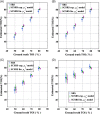Functional near infrared spectroscopy using spatially resolved data to account for tissue scattering: A numerical study and arm-cuff experiment
- PMID: 31169976
- PMCID: PMC7065609
- DOI: 10.1002/jbio.201900064
Functional near infrared spectroscopy using spatially resolved data to account for tissue scattering: A numerical study and arm-cuff experiment
Abstract
Functional Near-Infrared Spectroscopy (fNIRS) aims to recover changes in tissue optical parameters relating to tissue hemodynamics, to infer functional information in biological tissue. A widely-used application of fNIRS relies on continuous wave (CW) methodology that utilizes multiple distance measurements on human head for study of brain health. The typical method used is spatially resolved spectroscopy (SRS), which is shown to recover tissue oxygenation index (TOI) based on gradient of light intensity measured between two detectors. However, this methodology does not account for tissue scattering which is often assumed. A new parameter recovery algorithm is developed, which directly recovers both the scattering parameter and scaled chromophore concentrations and hence TOI from the measured gradient of light-attenuation at multiple wavelengths. It is shown through simulations that in comparison to conventional SRS which estimates cerebral TOI values with an error of ±12.3%, the proposed method provides more accurate estimate of TOI exhibiting an error of ±5.7% without any prior assumptions of tissue scatter, and can be easily implemented within CW fNIRS systems. Using an arm-cuff experiment, the obtained TOI using the proposed method is shown to provide a higher and more realistic value as compared to utilizing any prior assumptions of tissue scatter.
Keywords: near-infrared spectroscopy; tissue optics; tissue scattering.
© 2019 The Authors. Journal of Biophotonics published by WILEY-VCH Verlag GmbH & Co. KGaA, Weinheim.
Figures











Similar articles
-
Robustness of tissue oxygenation estimates by continuous wave space-resolved near infrared spectroscopy.J Biomed Opt. 2023 Jul;28(7):075002. doi: 10.1117/1.JBO.28.7.075002. Epub 2023 Jul 17. J Biomed Opt. 2023. PMID: 37465166 Free PMC article.
-
Investigation of Confounding Factors in Measuring Tissue Saturation with NIRS Spatially Resolved Spectroscopy.Adv Exp Med Biol. 2018;1072:307-312. doi: 10.1007/978-3-319-91287-5_49. Adv Exp Med Biol. 2018. PMID: 30178363 Free PMC article.
-
Cerebral oxygenation monitor during head-up and -down tilt using near-infrared spatially resolved spectroscopy.Clin Physiol Funct Imaging. 2003 Jul;23(4):177-81. doi: 10.1046/j.1475-097x.2003.00488.x. Clin Physiol Funct Imaging. 2003. PMID: 12914555
-
Time domain functional NIRS imaging for human brain mapping.Neuroimage. 2014 Jan 15;85 Pt 1:28-50. doi: 10.1016/j.neuroimage.2013.05.106. Epub 2013 Jun 5. Neuroimage. 2014. PMID: 23747285 Review.
-
[Near infrared spectroscopy: a noninvasive optical method for monitoring cerebral oxygenation and hemodynamics].Neurol Neurochir Pol. 1997 Nov-Dec;31(6):1227-37. Neurol Neurochir Pol. 1997. PMID: 9678996 Review. Polish.
Cited by
-
Near-Infrared Spectroscopy (NIRS) in Traumatic Brain Injury (TBI).Sensors (Basel). 2021 Feb 24;21(5):1586. doi: 10.3390/s21051586. Sensors (Basel). 2021. PMID: 33668311 Free PMC article. Review.
-
Robustness of tissue oxygenation estimates by continuous wave space-resolved near infrared spectroscopy.J Biomed Opt. 2023 Jul;28(7):075002. doi: 10.1117/1.JBO.28.7.075002. Epub 2023 Jul 17. J Biomed Opt. 2023. PMID: 37465166 Free PMC article.
-
Absolute quantification of cerebral tissue oxygen saturation with multidistance broadband NIRS in newborn brain.Biomed Opt Express. 2021 Jan 15;12(2):907-925. doi: 10.1364/BOE.412088. eCollection 2021 Feb 1. Biomed Opt Express. 2021. PMID: 33680549 Free PMC article.
-
Optimizing sensitivity and dynamic range of silicon photomultipliers for frequency-domain near infrared spectroscopy.Biomed Opt Express. 2020 Sep 1;11(9):5373-5387. doi: 10.1364/BOE.401439. eCollection 2020 Sep 1. Biomed Opt Express. 2020. PMID: 33014621 Free PMC article.
References
-
- Stiefel M. F., Spiotta A., Gracias V. H., Garuffe A. M., Guillamondegui O., Maloney‐Wilensky E., Bloom S., Grady M. S., LeRoux P. D., J. Neurosurg. 2005, 103, 805. - PubMed
-
- Hodgkinson S., Pollit V., Sharpin C., Lecky F., BMJ 2014, 348, g104. - PubMed
-
- Maloney‐Wilensky E., Gracias V., Itkin A., Hoffman K., Bloom S., Yang W., Christian S., LeRoux P. D., Crit. Care Med. 2009, 37, 2057. - PubMed
-
- White H., Venkatesh B. in Oxford textbook of neurocritical care, chapter 17: traumatic brain injury, Vol., Oxford University Press, 2016, p. 213‐215.
-
- Torricelli A., Contini D., Pifferi A., Caffini M., Re R., Zucchelli L., Spinelli L., Neuroimage 2014, 85, 28. - PubMed
Publication types
MeSH terms
Substances
Grants and funding
LinkOut - more resources
Full Text Sources

